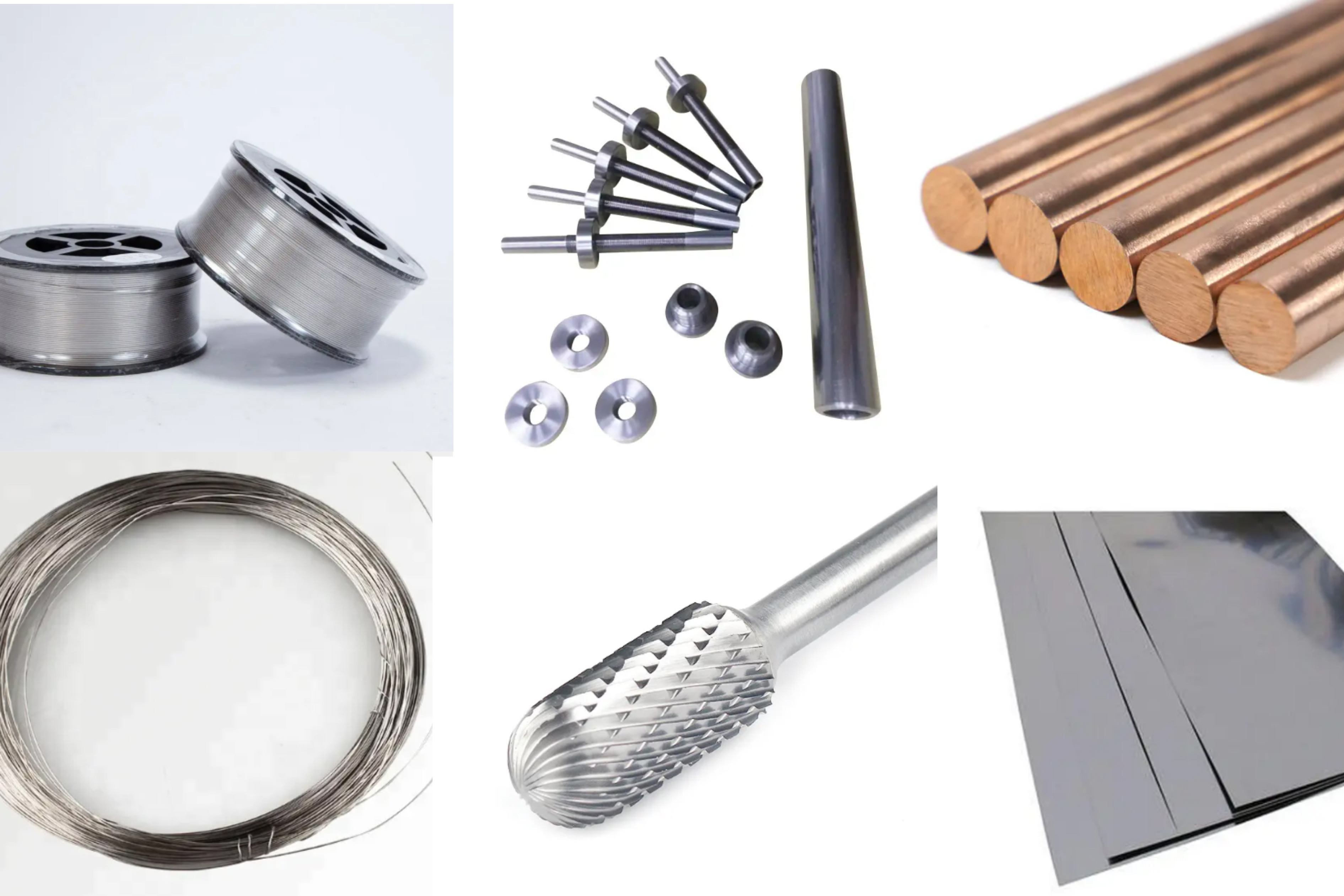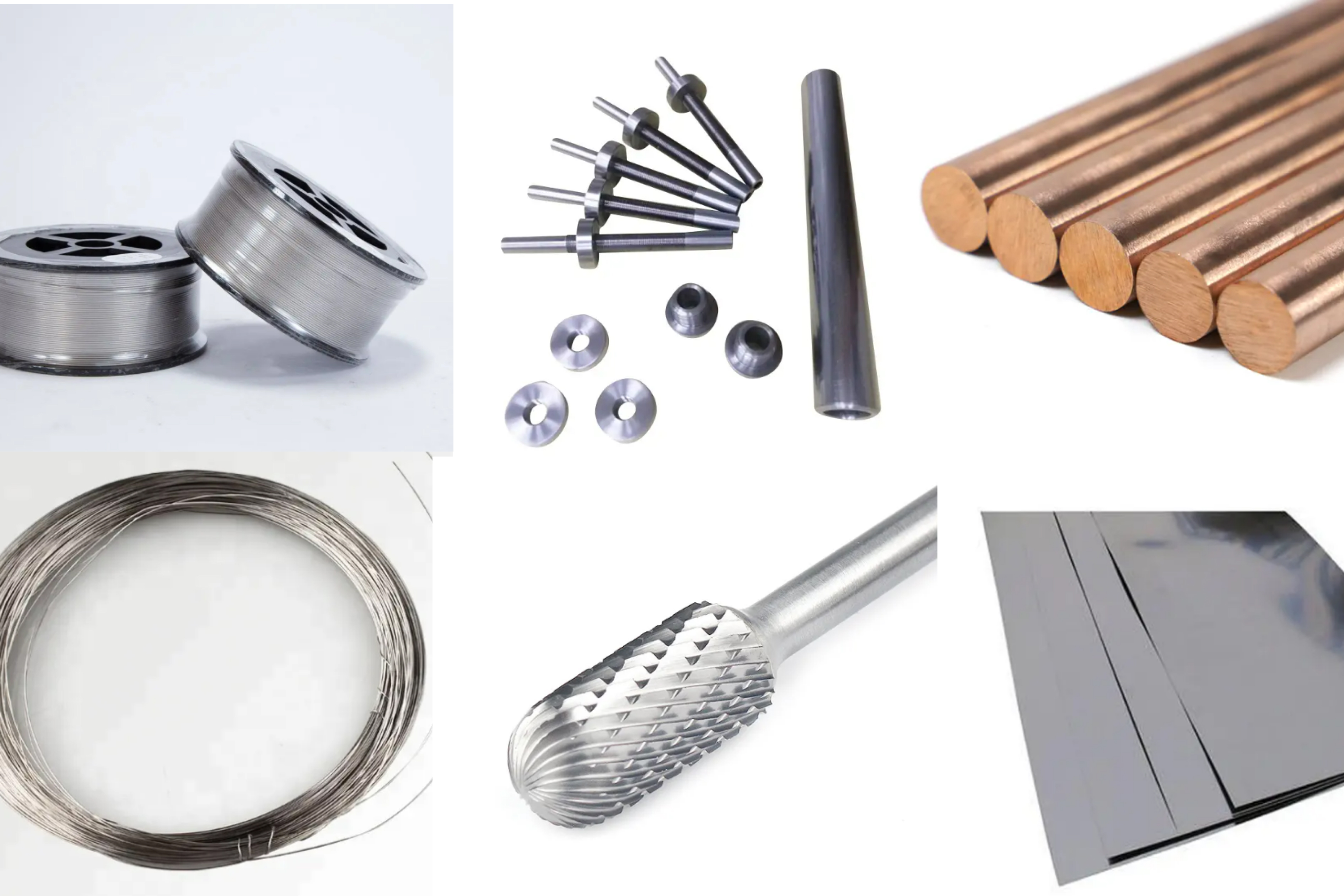Types of Tungsten Alloys and Their Applications

Tungsten alloys are known for their exceptional density, strength, and heat resistance. They serve critical roles in industries ranging from aerospace and defense to electronics and healthcare. Below are the major types, their compositions, and real-world applications with data and use cases.

1. Tungsten Heavy Alloys (WHA)
Tungsten heavy alloys (WHA) typically consist of 90–98% tungsten, with nickel (Ni), iron (Fe), or copper (Cu) serving as binders. These alloys have a high density, generally ranging from 17.0 to 18.8 g/cm³, making them ideal for applications where space and weight are critical.
In the aerospace industry, companies such as Boeing and Airbus use tungsten heavy alloy counterweights in components like ailerons and rudders. For example, on aircraft such as the Boeing 777, these counterweights provide the necessary balance stability within limited space constraints.
In medical applications, WHAs are commonly used as a non-toxic alternative to lead in radiation shielding. They are employed in radiotherapy collimators and syringe shields. A specific alloy composition, such as 95W-3.5Ni-1.5Fe, is used in Varian Linear Accelerators to improve machinability while reducing health and environmental concerns associated with lead.
2. Tungsten Copper (W-Cu) Alloys
Tungsten copper (W-Cu) alloys are commonly produced in ratios such as 70W/30Cu or 80W/20Cu. These alloys combine the strength and high melting point of tungsten with the excellent electrical and thermal conductivity of copper. In copper-rich grades, thermal conductivity typically ranges from 200 to 250 W/m·K.
One major application of W-Cu alloys is in electrical discharge machining (EDM). They are used to fabricate precision electrodes capable of machining hard materials like titanium and carbide dies. EDM systems from manufacturers such as Mitsubishi and Sodick often specify 70W/30Cu electrodes due to their long service life and minimal electrode wear.
Another significant use of W-Cu alloys is in high-voltage electrical contacts. In vacuum interrupters and arc-resistant circuit breakers manufactured by companies like ABB and Siemens, W-Cu contacts are essential for handling large current loads without melting or welding. For instance, a contact made from 80W/20Cu can reliably handle arc currents up to 20 kA, making it ideal for high-performance power systems.
3. Tungsten Carbide (WC) Alloys
Tungsten carbide (WC) alloys are composed of tungsten carbide particles bound with 3–25% cobalt or nickel, which act as a metallic binder to enhance toughness. These alloys are extremely hard, typically reaching 1600–2000 HV on the Vickers scale, making them ideal for high-wear applications.
In the tooling industry, WC alloys are widely used for manufacturing CNC inserts, drill bits, and end mills. Companies such as Sandvik Coromant and Kennametal produce WC-Co tools that are particularly effective for machining tough materials like aerospace-grade titanium and Inconel, where conventional tools would quickly wear out.
In the mining sector, tungsten carbide is used to tip cutting tools and drilling equipment. For example, Caterpillar employs WC-Co-tipped tools in coal cutting machinery. A typical WC-Co insert in these applications can last up to five times longer than steel tools when operating in hard rock environments.
Tungsten carbide is also utilized in military applications due to its density and hardness. Armor-piercing ammunition, such as the U.S. M993 5.56mm round, features a tungsten carbide core capable of penetrating over 12 millimeters of steel armor at a distance of 300 meters, providing superior ballistic performance.
4. Tungsten Rhenium (W-Re) Alloys
Tungsten-rhenium (W-Re) alloys are typically composed of 3%, 5%, or 26% rhenium, with the remainder being tungsten. These alloys are known for their exceptional high-temperature performance, with the W-26Re composition exhibiting a melting point of approximately 3050 °C. The addition of rhenium improves ductility, creep resistance, and structural integrity at elevated temperatures.
One key application of W-Re alloys is in thermocouples used for extreme temperature measurements. For instance, W-5Re/W-26Re thermocouples are employed in aerospace engine testing environments such as NASA’s hypersonic scramjet programs, where temperatures routinely exceed 2200 °C. These thermocouples provide reliable and accurate readings under conditions where conventional sensors would fail.
W-Re alloys are also under evaluation for use in nuclear fusion reactors. Due to their superior strength, thermal stability, and resistance to radiation damage, W-Re materials are being tested as plasma-facing components in major research projects like the International Thermonuclear Experimental Reactor (ITER) and the Joint European Torus (JET). Their ability to endure extreme thermal flux and neutron bombardment makes them promising candidates for future fusion power systems.
5. Tungsten Molybdenum (W-Mo) Alloys
Tungsten molybdenum (W-Mo) alloys typically contain 70–90% tungsten with 10–30% molybdenum. These alloys have a density of approximately 17.0 to 18.0 g/cm³ and a melting point around 2900 °C, falling between the melting points of pure tungsten and molybdenum. The addition of molybdenum enhances ductility and reduces the brittleness that pure tungsten often exhibits, particularly at elevated temperatures.
W-Mo alloys are commonly used in high-temperature industrial furnaces, where they serve as heating elements, support rods, and thermal shields. Their excellent thermal conductivity and resistance to deformation under heat make them ideal for use in vacuum and hydrogen atmosphere environments.
In the semiconductor industry, W-Mo alloys are used in rapid thermal processing (RTP) and chemical vapor deposition (CVD) equipment. Their dimensional stability and thermal performance allow them to function reliably as wafer supports and internal components exposed to high temperatures.
The aerospace sector also benefits from W-Mo alloys, particularly in applications such as rocket nozzle liners and reentry heat shields. These components require both thermal resilience and mechanical strength, and W-Mo alloys have been successfully tested in solid rocket motor throat inserts operating at temperatures exceeding 2500 °C. The combination of tungsten’s high-temperature strength and molybdenum’s improved machinability makes W-Mo alloys a valuable material for extreme thermal and mechanical environments.
Summary Table: Types and Uses of Tungsten Alloys
|
Alloy Type |
Composition |
Key Properties |
Typical Applications |
|
Tungsten Heavy Alloy (WHA) |
90–98% W, Ni/Fe or Cu binder |
High density (17–18.8 g/cm³), good machinability |
Aerospace counterweights, radiation shielding, defense components |
|
Tungsten Copper (W-Cu) |
70–90% W, balance Cu |
High thermal/electrical conductivity, arc resistance |
EDM electrodes, heat sinks, high-voltage contacts |
|
Tungsten Carbide (WC) |
WC + 3–25% Co or Ni binder |
Extreme hardness (1600–2000 HV), wear resistance |
Cutting tools, mining equipment, military penetrators |
|
Tungsten Rhenium (W-Re) |
3–26% Re, balance W |
High melting point (~3050 °C), thermal stability |
Thermocouples, aerospace propulsion, nuclear reactors |
|
Tungsten Molybdenum (W-Mo) |
70–90% W, 10–30% Mo |
Better ductility and thermal stability |
High-temp furnace parts, semiconductor equipment, aerospace heat shields |
For more tungsten products, please check Advanced Refractory Metals (ARM).
Conclusion
Tungsten alloys come with remarkable density, hardness, and heat resistance. They are essential materials in industries where performance under extreme conditions is critical. Advanced Refractory Metals (ARM) offers a wide range of tungsten-based materials tailored to specific application needs.
{{item.content}}
LEVE A REPLY
{{item.children[0].content}}
{{item.content}}






